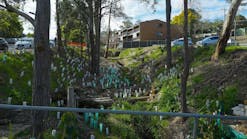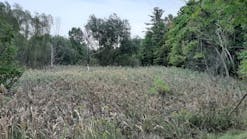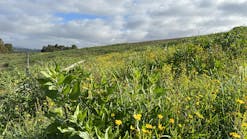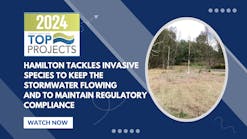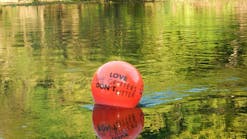For the last three years, crews with Loomis, CA-based Selby’s Soil Erosion Control have been spreading a mix of native seed, compost, and commercial fertilizers along an 8-mile stretch of new highway that runs around the northern California city of Brentwood.
It’s just one of the many major hydroseeding projects that Selby’s is now taking on. Jay Selby, president of the company, says that a growing number of municipalities and contractors are calling on Selby’s to hydroseed their construction sites as a way to prevent soil erosion.
And Selby, like other erosion control specialists, says he doesn’t expect the increased demand for hydroseeding to lessen.
“The federal and state regulations regarding soil erosion are becoming so much stricter, so people are looking for the best ways to control erosion on their job sites,” he says. “The hydroseeding industry is definitely a growing industry right now. It’s one that is not going anywhere.”
Selby is far from alone. Contractors, municipalities, state departments of transportation, and developers are more frequently turning to hydroseeding as a viable means of preventing erosion on their job sites.
The reasons are many: Hydroseeding is effective, providing a natural vegetative cover to keep soil in place. It is also relatively cheap. And with today’s new hydroseeding machines, crews can spray seed over construction sites in record time. The impact of the wildfires in California can’t be ignored, either; municipalities often turn to hydroseeding companies to help quickly revegetate areas that have been scorched bare.
The tougher regulations governing erosion on job sites are also playing a role in the growing strength of the hydroseeding industry. Contractors need to make sure that they control erosion effectively. If they don’t, they face significant fines both on the state and federal levels. Hydroseeding does contain erosion, and it does it well.
For these reasons, Selby says, business at his company remains steady. “We are working on a ton of state projects right now,” he says. “And then there are the wildfire jobs. As we are talking, there are over 600 wildfires in northern California. We expect to have a lot of work on the wildfires this year.”
A Strong Industry
When Scott Harrison looks at the hydroseeding industry, he sees a bright future. Hydroseeding has always been common practice in California, where Harrison works for Bakersfield-based Terra Novo, a manufacturer of EarthGuard, a fiber matrix that can be applied as a tackifier and often used for hydroseeding projects.
But now, he says, this erosion control method is gaining in popularity across the country as well. Part of the reason is that crews can seed large amounts of areas quickly when using hydroseeding machines and mixes. Harrison estimates that crews operating a large machine can hydroseed 8 to 10 acres a day.
“This has been a real common practice in California over the last decade or so,” Harrison says. “Now we are seeing it being more widely accepted in other parts of the nation and internationally. In the past, a lot of these other areas relied on erosion control blankets and other products to control erosion. They’ve now found that hydroseeding actually works quite well with other quality erosion control products to allow people to seed large areas quickly and effectively.”
A constant source of business has come from areas impacted by frequent wildfires.
“You’ll see a lot of hydroseeding being done in emergency situations after fires,” Harrison says. “If you are going to re-seed an area to protect roadways and cities that might be near fire-damaged areas, hydroseeding is a very efficient way to go. Then you’ll have protection from impending storm events.”
Not every manufacturer, though, sees hydroseeding as a business with unlimited growth in the near term. Andrew Blubaugh of Haven, KS-based Kincaid Equipment Manufacturing, a company that manufactures hydroseeding equipment including the AgiGator line of mulcher/seeder machines, says that the struggling economy has had an impact on the hydroseeding industry just as on many others. That is something that won’t change until the housing and construction industries bounce back from their own slowdowns, he says.
“With the economy, there has been a downsizing of this industry,” Blubaugh says. “There is some growth because of the higher demand for green building. The erosion control industry is definitely growing somewhat with the green industry. But the economy’s impact has been greater. It’s definitely not a dying industry, but the economy is slowing things down a bit.”
One portion of the erosion control industry that has boosted the demand for hydroseeding is the land reclamation work that is needed after landowners put in oil and gas wells, Blubaugh says.
“That is something that in the last year is really starting to pop up,” he says. “A lot more states are requiring that after a certain number of days after the wells are put in, the ground be completely covered for erosion control purposes.”
Gary Meyer, owner of Bowie, TX-based Bowie Industries, which manufactures its own line of Hydro-Mulchers and Aero-Mulchers, agrees that the economy has affected the growth of the industry.
“Things have slowed down, and I think it’s because of the economy,” he says. “We’re hoping to see a rebound when the economy finally does pick up.”
When the economy does perk up, Meyer’s company is poised to take advantage. Bowie sells a wide range of hydroseeding machines, ranging from 300-gallon versions powered by 13-horsepower engines to custom-built machines of 6,000 gallons.
The company’s end users are as varied, encompassing contractors planting residential lawns and golf courses to department of transportation officials building new highways.
A big part of Meyer’s business, though, comes from contractors concerned about controlling erosion on their job sites. This is because hydroseeding
is especially effective in preventing erosion, Meyer says. Erosion control mats, for instance, lay atop soil. If heavy rains hit them, the water can slip under the mats.
“If you’re really serious about holding soil in place, you go with bonded fiber matrix,” Meyer says. “That’s what really keeps soil erosion from happening. When you use mats or blankets, the water is free to go right under them. That doesn’t happen when you hydroseed with the right mixture.”
A Variety of Uses
Erosion control specialists rely on hydroseeding for a variety of uses. That’s something that hasn’t changed, even as the
nation’s economy struggles to shake off its slump.
For instance, there’s Selby’s highway, the four-lane State Route 4 Bypass near Brentwood. One of the key requirements for this job was that construction crews prevent soil erosion. The new bypass runs close to the ocean. Any soil runoff could end up in the San Francisco Bay.
The job has been a lengthy one, with Selby’s crews following behind workers digging up the dirt for the new bypass. As the workers move the dirt, Selby’s crews, armed with their hydroseeding machines, spray a mixture of native seeds, compost, and commercial fertilizer over the bare earth. They then come back and blow straw over the whole area before returning a third time to apply a tackifier and wood fiber combination. The three-step process has been one that Selby’s crews have been repeating on the project now for three years.
“We do a lot of work with the California Department of Transportation,” Selby says. “The work we do with restoring land after wildfires probably gets more press, but we actually do a lot more work with developers and the department of transportation. Those are more typical jobs than are the wildfire ones.”
That doesn’t mean, though, that wildfire work doesn’t make up an important part of Selby’s business. Last fall, the company hydroseeded 636 acres in South Lake Tahoe, CA, that had been scorched by the Angora Fire. That fire eventually burned more than 3,000 acres.
The area that Selby’s company had to hydroseed was unreachable by the ground. Selby’s crews created a mix of wood fiber and tackifier-2,000 pounds per acre of wood fiber and 100 pounds per acre of tackifier-and pumped it into private airplanes. The planes then flew over the burned acres and released the mixture.
“That was quite a project,” Selby says. “We’d never done something like that before. It was definitely a first.
The fire project highlights a key consideration when contractors are hydroseeding an area: It’s important to approach sites with the right seed combination.
For the Angora Fire work, Selby’s crews did not include any seed in their hydroseeding mixture. That’s because the hydroseeding mixture was only for soil stabilization. State officials had determined that the native plants would re-establish themselves without the help of a specialized seed mixture.
“It is definitely crucial to have the right mixture to fit whatever project you are working on,” Selby says. “If you go to with the wrong mixture, you
won’t do any good.”
Leo Brendis, owner of Hydrosprout Inc. in Escondido, CA, also tackles a wide variety of hydroseeding work.
For the last four years, his company has been hydroseeding behind contractors building the new extension of State Route 125 in San Diego. The new toll road, which will run from San Diego County’s State Route 905 near the international border with Mexico to State Route 54, will fill in the last missing link in what is becoming only the third full north-south highway in San Diego.
Overall, Brendis’ crews have been hydroseeding about 9 miles of roadside for the project.
Hydrosprout workers have sprayed the construction site with a bonded fiber matrix mix for erosion protection. The crews are also tackling the follow-up work on the site, adding ornamental and native plants to the site for additional erosion protection.
“We do so many different kinds of jobs,” Brendis says. “We could be out in the desert doing a golf course or hydroseeding around large parks or schools in the summer. There is always something for us to work on.”
Like other hydroseeding companies in the area, Hydrosprout also tackles its share of wildfire work. In March, the company seeded 110 acres at the US Marine Corps’ Camp Pendleton, a base located between the Southern California cities of Oceanside and San Clemente. Another wildfire had burned on this plot of land.
Many of the areas that Hydrosprout had to reach were also inaccessible by land. The company, then, created its hydroseeding mix, and then watched as it was transported by helicopter above the inaccessible areas. The helicopters performed aerial drops in the course of a week over those areas. The helicopters were loaded with a native seed mix of shrubs and native grasses.
“We were trying to help Mother Nature put back what was lost,” Brendis says. “There was the feeling that they might have lost some species due to the fire.”
Brendis says that he expects his company’s business to remain steady as more contractors look to hydroseeding to control erosion.
“We’ve been at this since 1988. It’s been a real consistent business for us,” Brendis says. “We’ve had a lot of growth, I remember, in our first 15 years. We were growing every year. In the last five, we have probably captured as much of the market as we are going to get right now. We get a lot of calls for hydroseeding, though, from the people we work with. This has been a steady business. We get year-round erosion control here in California. The people here are very sophisticated when it comes to the importance of preventing erosion.”
A Host of Benefits
Kincaid Equipment Manufacturing makes a range of hydroseeding machines, from models that hold 425 gallons to those as large as 1,200 gallons. The company’s clients range from small landscapers to large hydroseeding and erosion control contractors to state and county landfills.
These clients choose hydroseeding primarily because it saves them time and money, Blubaugh says. “Hydroseeding is such a fast and easy application,” he says. “There is a great cost effectiveness, say, for the small landscaper. They can use these machines to seed a large acreage at a time. It is more efficient than having them work the ground, put fertilizer and seed down, and keep it watered. This provides the mulch, fertilizer, and seed all in one tank. In seven to 14 days, you have a solid grass stand.”
Choosing the right seed mix is critical. There are hundreds of mulches available for different applications, most dependent on what the job entails. Blubaugh says that for erosion control, contractors generally use 1,500 to 2,500 pounds of mulch per acre. That can change, though, depending on the slope of a job site. If working on mountain or hillsides, contractors will use a greater amount of mulch.
Harrison, from Terra Novo, says that hydroseeding is always in demand because the technique works.
“When you are hydroseeding, you are creating an environment that is conducive for seed germination,”
he says. “It does not harden when pressed over, so it doesn’t create a crust. There are no growth-inhibiting factors that would prevent the seeds from germinating. It allows water to infiltrate into the soil. It allows the water to be retained, which the seeds need [in order] to grow properly.”
Hydroseeding, though, can’t be effective if contractors don’t use the technique properly. As hydroseeding becomes more popular across the country, contractors are making fewer mistakes, Harrison says.
But there are still errors that they have to watch out for, he notes. The biggest potential problem is when seeds don’t stay in place after hydroseeding. This, of course, defeats the entire purpose of the technique. That’s why Harrison recommends that contractors use proper best management practices (BMPs), such as EarthGuard fiber matrix, to hold seed mixtures in place.
“One of the main keys in hydroseeding is making sure the seeds are staying in place,” Harrison says. “You have to make sure the seeds are staying in place long enough, even through what could be multiple rain events. You need to have proper BMPs in place. You have to ensure that there is stability during the first few months after the hydroseeding to make sure that the seed and soil stay in place.”







